Chenying Liu
Towards a Unified Copernicus Foundation Model for Earth Vision
Mar 14, 2025Abstract:Advances in Earth observation (EO) foundation models have unlocked the potential of big satellite data to learn generic representations from space, benefiting a wide range of downstream applications crucial to our planet. However, most existing efforts remain limited to fixed spectral sensors, focus solely on the Earth's surface, and overlook valuable metadata beyond imagery. In this work, we take a step towards next-generation EO foundation models with three key components: 1) Copernicus-Pretrain, a massive-scale pretraining dataset that integrates 18.7M aligned images from all major Copernicus Sentinel missions, spanning from the Earth's surface to its atmosphere; 2) Copernicus-FM, a unified foundation model capable of processing any spectral or non-spectral sensor modality using extended dynamic hypernetworks and flexible metadata encoding; and 3) Copernicus-Bench, a systematic evaluation benchmark with 15 hierarchical downstream tasks ranging from preprocessing to specialized applications for each Sentinel mission. Our dataset, model, and benchmark greatly improve the scalability, versatility, and multimodal adaptability of EO foundation models, while also creating new opportunities to connect EO, weather, and climate research. Codes, datasets and models are available at https://github.com/zhu-xlab/Copernicus-FM.
Designing Kresling Origami for Personalised Wrist Orthosis
Jan 30, 2025Abstract:The wrist plays a pivotal role in facilitating motion dexterity and hand functions. Wrist orthoses, from passive braces to active exoskeletons, provide an effective solution for the assistance and rehabilitation of motor abilities. However, the type of motions facilitated by currently available orthoses is limited, with little emphasis on personalised design. To address these gaps, this paper proposes a novel wrist orthosis design inspired by the Kresling origami. The design can be adapted to accommodate various individual shape parameters, which benefits from the topological variations and intrinsic compliance of origami. Heat-sealable fabrics are used to replicate the non-rigid nature of the Kresling origami. The orthosis is capable of six distinct motion modes with a detachable tendon-based actuation system. Experimental characterisation of the workspace has been conducted by activating tendons individually. The maximum bending angle in each direction ranges from 18.81{\deg} to 32.63{\deg}. When tendons are pulled in combination, the maximum bending angles in the dorsal, palmar, radial, and ulnar directions are 31.66{\deg}, 30.38{\deg}, 27.14{\deg}, and 14.92{\deg}, respectively. The capability to generate complex motions such as the dart-throwing motion and circumduction has also been experimentally validated. The work presents a promising foundation for the development of personalised wrist orthoses for training and rehabilitation.
AutoLCZ: Towards Automatized Local Climate Zone Mapping from Rule-Based Remote Sensing
May 22, 2024



Abstract:Local climate zones (LCZs) established a standard classification system to categorize the landscape universe for improved urban climate studies. Existing LCZ mapping is guided by human interaction with geographic information systems (GIS) or modelled from remote sensing (RS) data. GIS-based methods do not scale to large areas. However, RS-based methods leverage machine learning techniques to automatize LCZ classification from RS. Yet, RS-based methods require huge amounts of manual labels for training. We propose a novel LCZ mapping framework, termed AutoLCZ, to extract the LCZ classification features from high-resolution RS modalities. We study the definition of numerical rules designed to mimic the LCZ definitions. Those rules model geometric and surface cover properties from LiDAR data. Correspondingly, we enable LCZ classification from RS data in a GIS-based scheme. The proposed AutoLCZ method has potential to reduce the human labor to acquire accurate metadata. At the same time, AutoLCZ sheds light on the physical interpretability of RS-based methods. In a proof-of-concept for New York City (NYC) we leverage airborne LiDAR surveys to model 4 LCZ features to distinguish 10 LCZ types. The results indicate the potential of AutoLCZ as promising avenue for large-scale LCZ mapping from RS data.
CromSS: Cross-modal pre-training with noisy labels for remote sensing image segmentation
May 02, 2024


Abstract:We study the potential of noisy labels y to pretrain semantic segmentation models in a multi-modal learning framework for geospatial applications. Specifically, we propose a novel Cross-modal Sample Selection method (CromSS) that utilizes the class distributions P^{(d)}(x,c) over pixels x and classes c modelled by multiple sensors/modalities d of a given geospatial scene. Consistency of predictions across sensors $d$ is jointly informed by the entropy of P^{(d)}(x,c). Noisy label sampling we determine by the confidence of each sensor d in the noisy class label, P^{(d)}(x,c=y(x)). To verify the performance of our approach, we conduct experiments with Sentinel-1 (radar) and Sentinel-2 (optical) satellite imagery from the globally-sampled SSL4EO-S12 dataset. We pair those scenes with 9-class noisy labels sourced from the Google Dynamic World project for pretraining. Transfer learning evaluations (downstream task) on the DFC2020 dataset confirm the effectiveness of the proposed method for remote sensing image segmentation.
AIO2: Online Correction of Object Labels for Deep Learning with Incomplete Annotation in Remote Sensing Image Segmentation
Mar 03, 2024

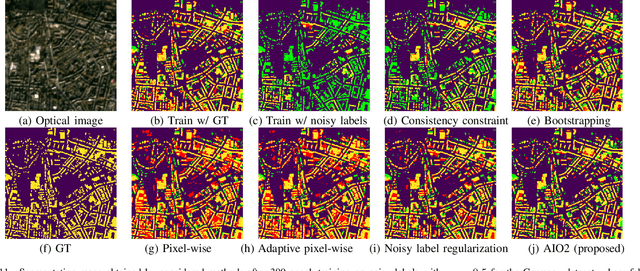

Abstract:While the volume of remote sensing data is increasing daily, deep learning in Earth Observation faces lack of accurate annotations for supervised optimization. Crowdsourcing projects such as OpenStreetMap distribute the annotation load to their community. However, such annotation inevitably generates noise due to insufficient control of the label quality, lack of annotators, frequent changes of the Earth's surface as a result of natural disasters and urban development, among many other factors. We present Adaptively trIggered Online Object-wise correction (AIO2) to address annotation noise induced by incomplete label sets. AIO2 features an Adaptive Correction Trigger (ACT) module that avoids label correction when the model training under- or overfits, and an Online Object-wise Correction (O2C) methodology that employs spatial information for automated label modification. AIO2 utilizes a mean teacher model to enhance training robustness with noisy labels to both stabilize the training accuracy curve for fitting in ACT and provide pseudo labels for correction in O2C. Moreover, O2C is implemented online without the need to store updated labels every training epoch. We validate our approach on two building footprint segmentation datasets with different spatial resolutions. Experimental results with varying degrees of building label noise demonstrate the robustness of AIO2. Source code will be available at https://github.com/zhu-xlab/AIO2.git.
Task Specific Pretraining with Noisy Labels for Remote sensing Image Segmentation
Feb 25, 2024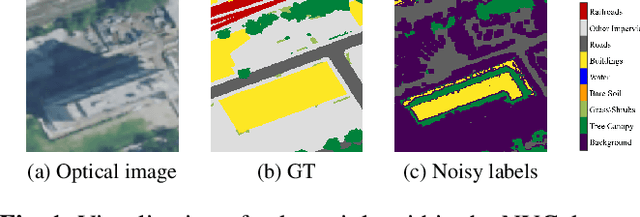



Abstract:In recent years, self-supervision has drawn a lot of attention in remote sensing society due to its ability to reduce the demand of exact labels in supervised deep learning model training. Self-supervision methods generally utilize image-level information to pretrain models in an unsupervised fashion. Though these pretrained encoders show effectiveness in many downstream tasks, their performance on segmentation tasks is often not as good as that on classification tasks. On the other hand, many easily available label sources (e.g., automatic labeling tools and land cover land use products) exist, which can provide a large amount of noisy labels for segmentation model training. In this work, we propose to explore the under-exploited potential of noisy labels for segmentation task specific pretraining, and exam its robustness when confronted with mismatched categories and different decoders during fine-tuning. Specifically, we inspect the impacts of noisy labels on different layers in supervised model training to serve as the basis of our work. Experiments on two datasets indicate the effectiveness of task specific supervised pretraining with noisy labels. The findings are expected to shed light on new avenues for improving the accuracy and versatility of pretraining strategies for remote sensing image segmentation.
DeCUR: decoupling common & unique representations for multimodal self-supervision
Sep 15, 2023Abstract:The increasing availability of multi-sensor data sparks interest in multimodal self-supervised learning. However, most existing approaches learn only common representations across modalities while ignoring intra-modal training and modality-unique representations. We propose Decoupling Common and Unique Representations (DeCUR), a simple yet effective method for multimodal self-supervised learning. By distinguishing inter- and intra-modal embeddings, DeCUR is trained to integrate complementary information across different modalities. We evaluate DeCUR in three common multimodal scenarios (radar-optical, RGB-elevation, and RGB-depth), and demonstrate its consistent benefits on scene classification and semantic segmentation downstream tasks. Notably, we get straightforward improvements by transferring our pretrained backbones to state-of-the-art supervised multimodal methods without any hyperparameter tuning. Furthermore, we conduct a comprehensive explainability analysis to shed light on the interpretation of common and unique features in our multimodal approach. Codes are available at \url{https://github.com/zhu-xlab/DeCUR}.
Deep Semantic Model Fusion for Ancient Agricultural Terrace Detection
Aug 04, 2023Abstract:Discovering ancient agricultural terraces in desert regions is important for the monitoring of long-term climate changes on the Earth's surface. However, traditional ground surveys are both costly and limited in scale. With the increasing accessibility of aerial and satellite data, machine learning techniques bear large potential for the automatic detection and recognition of archaeological landscapes. In this paper, we propose a deep semantic model fusion method for ancient agricultural terrace detection. The input data includes aerial images and LiDAR generated terrain features in the Negev desert. Two deep semantic segmentation models, namely DeepLabv3+ and UNet, with EfficientNet backbone, are trained and fused to provide segmentation maps of ancient terraces and walls. The proposed method won the first prize in the International AI Archaeology Challenge. Codes are available at https://github.com/wangyi111/international-archaeology-ai-challenge.
DeepLCZChange: A Remote Sensing Deep Learning Model Architecture for Urban Climate Resilience
Jun 09, 2023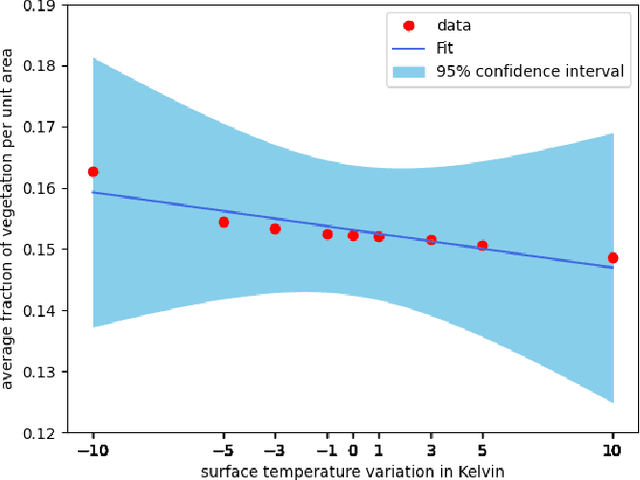



Abstract:Urban land use structures impact local climate conditions of metropolitan areas. To shed light on the mechanism of local climate wrt. urban land use, we present a novel, data-driven deep learning architecture and pipeline, DeepLCZChange, to correlate airborne LiDAR data statistics with the Landsat 8 satellite's surface temperature product. A proof-of-concept numerical experiment utilizes corresponding remote sensing data for the city of New York to verify the cooling effect of urban forests.
SSL4EO-S12: A Large-Scale Multi-Modal, Multi-Temporal Dataset for Self-Supervised Learning in Earth Observation
Nov 13, 2022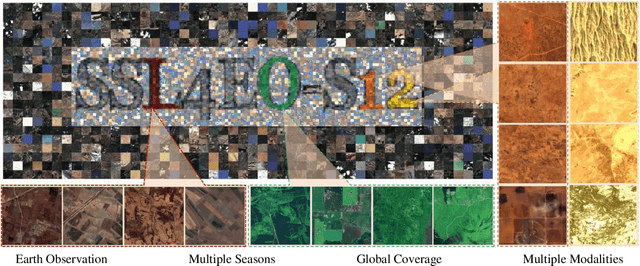
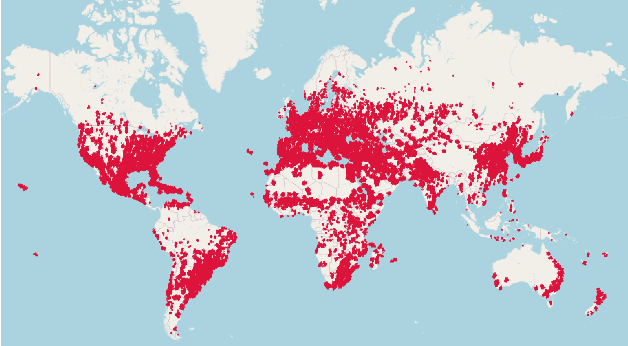
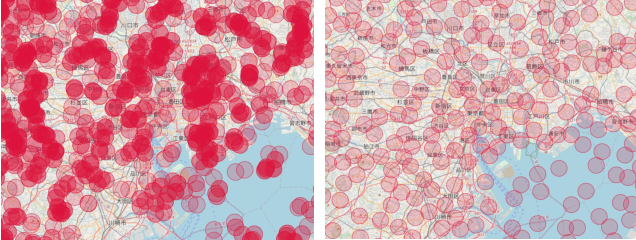

Abstract:Self-supervised pre-training bears potential to generate expressive representations without human annotation. Most pre-training in Earth observation (EO) are based on ImageNet or medium-size, labeled remote sensing (RS) datasets. We share an unlabeled RS dataset SSL4EO-S12 (Self-Supervised Learning for Earth Observation - Sentinel-1/2) to assemble a large-scale, global, multimodal, and multi-seasonal corpus of satellite imagery from the ESA Sentinel-1 \& -2 satellite missions. For EO applications we demonstrate SSL4EO-S12 to succeed in self-supervised pre-training for a set of methods: MoCo-v2, DINO, MAE, and data2vec. Resulting models yield downstream performance close to, or surpassing accuracy measures of supervised learning. In addition, pre-training on SSL4EO-S12 excels compared to existing datasets. We make openly available the dataset, related source code, and pre-trained models at https://github.com/zhu-xlab/SSL4EO-S12.
 Add to Chrome
Add to Chrome Add to Firefox
Add to Firefox Add to Edge
Add to Edge